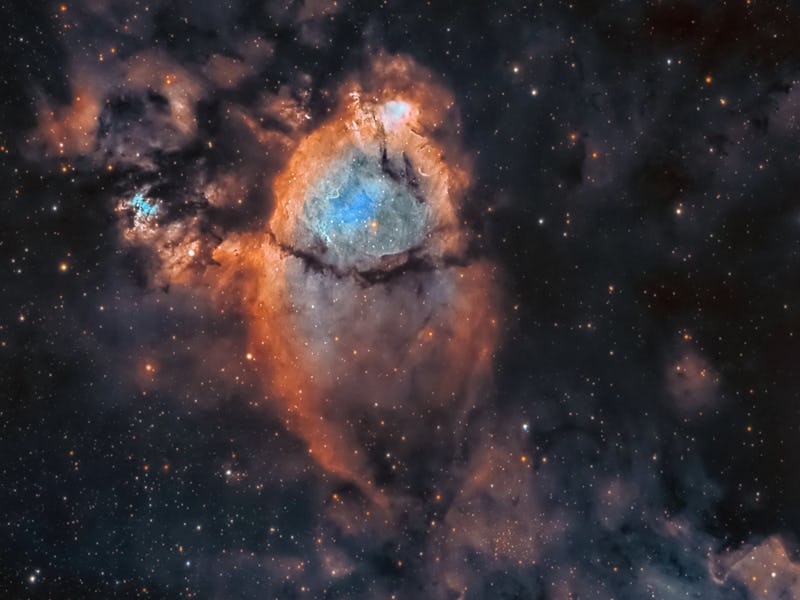How to capture the universe from your backyard
More and more people are getting into this celestial hobby.

"When you look up at the sky, there’s this whole universe out there that we can’t see."
Chuck Ayoub bought his first telescope as a teenager. Decades later, the retired 53-year-old has turned his attention back to the cosmos.
Ayoub restarted his passion by taking photos of celestial objects using his iPhone from his backyard in Detroit. As his interest in the universe blossomed, Ayoub began investing in more specialized equipment to capture planets, nebulae, and galaxies in ever-higher resolution and reveal the majestic details of the cosmos.
"I never thought I'd be able to do this from my backyard," Ayoub tells Inverse.
Since retiring five years ago, the former computer scientist has become increasingly adept at uncovering the beauty above us, undetectable to the naked eye.
Today, Ayoub has an avid following on Reddit, Facebook, and Instagram, and more than 27,000 subscribers to his YouTube channel, where he shares tips on how to capture the cosmos.
Ayoub captures the beauty of the universe in fine detail.
Recently, Ayoub uploaded a video to Reddit that shows some of our Solar System's famous planets which he photographed in the year 2020.
"It just seemed they were all in a very good spot to capture," Ayoub says. "In a single month, I was able to capture Jupiter, Saturn, and Venus."
Ayoub also caught the famous planetary conjunction between Jupiter and Saturn, which took place on December 21, 2020.
Inverse spoke to Ayoub to learn more about his passion, and get tips on how to do it ourselves.
Q: Do you remember that night of the conjunction, how was it shooting it?
A: It wasn’t easy because by the time they were really close together they were very low to the horizon.
Q: How long did it take you to shoot the conjunction?
A: I only had about 40-45 minutes to get the shot then you had the clouds out there and there’s things obstructing the view because it’s so low to the ground. It’s too bad they were that low, we couldn’t enjoy it for very long.
Jupiter holds a special place for Ayoub as it was the very first planet he ever shot when he began venturing into astrophotography five years ago.
"Planets are a whole different animal," he says. "In order to get a time-lapse of Jupiter, you need to point toward the planet for hours."
The Horsehead Nebula, one of the most identifiable nebula in deep space.
After conquering his first planet, Ayoub ventured deeper into space to capture the complicated beauty of nebulas. Nebulas are a giant cloud of dust and gas, originating from the explosive death of a star or the birth of a new one.
Q: What is your favorite nebula to shoot?
A: The Horsehead is one of my favorites, because it’s so recognizable.
Q: How did you capture this image of the Horsehead Nebula?
A: The Horsehead Nebula was not going to come into view for me until around 4 a.m. and staying up to wait for it was not an option. So I setup Sequence Generator Pro (SGP) to automatically start at 4am, went to bed and hoped for the best.
The first deep-space image Ayoub ever captured was that of the Orion Nebula, located south of Orion's belt in the Milky Way galaxy.
"It wasn’t very good of course, I didn’t know what I was doing," he says. "I thought you could take a picture with a single exposure, I didn’t know people were going hours and hours a day for a single picture."
The Andromeda galaxy is our closest galactic neighbor.
Aside from nebula, Ayoub also often points his telescope towards neighboring galaxies.
The Andromeda galaxy is the closest major galaxy to our own, the Milky Way, located only 2.5 million light-years away from Earth.
Q: Do you remember the night when you finally captured the Andromeda galaxy?
A: I pointed my telescope at this galaxy for 6 hours to capture this shot. When you know something is there and you can’t see it, then you point the telescope at it ...and there it is.
Ayoub is still amazed that he is able to do this from his backyard.
"When you look up at the sky, there’s this whole universe out there that we can’t see but when you point the telescope at it for hours and hours, it just reveals so much," he says. "It amazes me what turns up."
The Veil Nebula is one of many celestial beings that Ayoub has captured over the years.
This past year, Ayoub has noticed that a lot more people have gotten interested in practicing astrophotography as a hobby since being on lockdown due to Covid-19.
He notes that it has even become more difficult to buy a telescope nowadays since there are more people investing in this today than he's ever seen.
But to get started in this hobby, you really don't need that much.
"Everybody always asks me, how much do you need to spend to get into this hobby," Ayoub says. "And I always say, all you need is a DSLR camera and a star tracker."
Ayoub didn't even know astrophotography existed five years ago, and now he has captured more celestial objects than he could have ever dreamed of.
"I've done so much, that I'm not even sure what to do this year," Ayoub says.
Ayoub will keep pointing his gaze upwards looking for inspiration, capturing the beauty of celestial beings as they dance around in the universe, cloaked by shadows of gas and dust.